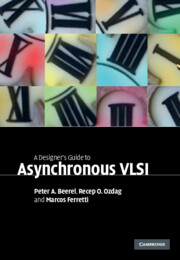Book contents
- Frontmatter
- Contents
- Acknowledgments
- 1 Introduction
- 2 Channel-based asynchronous design
- 3 Modeling channel-based designs
- 4 Pipeline performance
- 5 Performance analysis and optimization
- 6 Deadlock
- 7 A taxonomy of design styles
- 8 Synthesis-based controller design
- 9 Micropipeline design
- 10 Syntax-directed translation
- 11 Quasi-delay-insensitive pipeline templates
- 12 Timed pipeline templates
- 13 Single-track pipeline templates
- 14 Asynchronous crossbar
- 15 Design example: the Fano algorithm
- Index
- References
13 - Single-track pipeline templates
Published online by Cambridge University Press: 26 February 2010
- Frontmatter
- Contents
- Acknowledgments
- 1 Introduction
- 2 Channel-based asynchronous design
- 3 Modeling channel-based designs
- 4 Pipeline performance
- 5 Performance analysis and optimization
- 6 Deadlock
- 7 A taxonomy of design styles
- 8 Synthesis-based controller design
- 9 Micropipeline design
- 10 Syntax-directed translation
- 11 Quasi-delay-insensitive pipeline templates
- 12 Timed pipeline templates
- 13 Single-track pipeline templates
- 14 Asynchronous crossbar
- 15 Design example: the Fano algorithm
- Index
- References
Summary
Introduction
The single-track protocol, introduced in Chapter 2, was initially proposed by van Berkel and Blink as a communication method for bundled-data pipeline controllers. As an example, Figure 13.1 shows a single-track synchronization channel implemented with a single wire between a sender and a receiver. In this example, the sender sends a synchronization token by driving the channel wire high and the receiver detects the token and resets the channel by resetting the wire low. This is then detected by the sender, which may send a second token by raising the channel wire high again and thus repeating the entire handshaking process. An alternative form of this protocol is also possible in which the sender drives the communication wire low and the receiver drives it high.
Unlike other two-phase protocols, the single-track protocol returns the communication wire to its initial state. This enables single-track templates to react to only one type of transition, avoiding the need for the complex PMOS transistor networks that are a source of area and power inefficiencies for templates that use two-phase transition signaling, i.e. a non-return-to-zero protocol. Moreover, compared with four-phase protocols the single-track protocol has fewer wire transitions, only two instead of four, to complete a handshake, leading to improved power consumption per transmitted bit. Finally, because this protocol does not use an acknowledge wire it requires fewer wires than protocols that use distinct request and acknowledge wires.
Information
- Type
- Chapter
- Information
- A Designer's Guide to Asynchronous VLSI , pp. 267 - 303Publisher: Cambridge University PressPrint publication year: 2010
